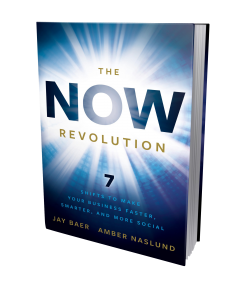 As some of you know, one of my New Year’s Resolutions was to read 26 books in 2011. I’m happy to report I’m already four books in. Number four was a rather brisk, but enjoyable read by two folks I love reading regularly: Jay Baer and Amber Naslund.
As some of you know, one of my New Year’s Resolutions was to read 26 books in 2011. I’m happy to report I’m already four books in. Number four was a rather brisk, but enjoyable read by two folks I love reading regularly: Jay Baer and Amber Naslund.
The book reads a lot like a “how to” book for adopting key social media tenets. For me, and many other folks who have been living online for a while, there’s not a lot of new ground covered here. But, then again, we’re not exactly Jay and Amber’s target audience.
For the unititiated, the book offers a number of great lessons. I’m not going to go into great detail here breaking down the book section by section. You can find much better reviews by Jason Falls, Nikki Stephan, Patrick Garmoe and Aaron Lee.
But, since the book was based on the seven shifts to make your business faster, smarter and more social, I wanted to offer up seven lessons I took away from the book:
* Characteristics you look for in employees are changing. The book has a great graphic that highlights the charachteristics organization’s used to look for in employees and those they should start looking for today. Curiousity, enthusiasm, humility and connectivity were a few of the more notable characteristics. Further proof that today’s marketer/PR is changing–are you adapting?
* Do social roles have a future? The book also outlines a number of new positions that are popping up inside companies big and small across the world. Social anthropologists, internal community managers and social media analysts, just to name a few. My question: How long a shelf life do these types of social media specific positions have? My opinion? I think eventually they’ll become more a part of a marketer/PR job–instead of one-off positions.
* The critical importance of using social media behind the firewall. This was a key theme that emerged consistently throughout the book. And, it’s one I don’t think is talked about nearly enough, so I’m glad Jay and Amber chose to highlight it. Using social tools internally to share, collaborate, innovate and identify “social objects” you can share across the Web is critical. And, thanks to the advent of tools like Facebook and LinkedIn groups, you no longer have to rely on expensive, off-the-shelf type products to create your own internal social network. So, I guess the real question is, what’s stopping you now?
* Coordinate your efforts–or die. Jay brought up the Timberwolves example in the book, which I found interesting because I remember when Jay blogged about that very example last year. The lesson? Make sure the left hand is talking to the right hand within your organization. You could have the greatest idea that’e executed across your social channels, but if your Web site (and other key media) doesn’t reinforce that idea/message, it’s all wasted time and effort. Make sure your internal teams are meeting regularly, sharing notes and collaborating so you avoid this kind of snafu.
* Social objects=information annuities. One of my favorite metaphors of the book. Jay and Amber refer to your social content online as “information annuities” that pay off time and time again (as compared to that direct mail piece which is seen once and thrown away forever). Just gives you a different way to think about why social content is so important. It’s archivable and searchable–forever.
* Complete vs. Extrapolated data. The example used in the book to highlight this point is the Nielsen data vs. online data. And, the argument is a good one. Worth thinking about as you consider the “ROI” of social media? Is it really that much different than the ROI of your advertising campaign? Your mass media outreach? You could make a pretty good argument that online and social data gives you much MORE information than just about anything you’ve done in the past.
* It’s not what you measure–it’s how you analyze that data. Not surprisingly, Jay and Amber nailed this point that seems to challenge many. Measuring itself isn’t the hard part–it’s taking that data, analyzing it and using it to further achieve your goals and objectives. And, I loved the authors’ point of setting aside time for this analysis and building it into your measurement process. Great tip for companies that are just getting started.
Finally, Jay and Amber were gracious enough to provide me with a book to give away to the community. Given the lessons I outlined above, which do you feel is most important to today’s business and why? Leave your comment below for a chance to win the book (I’ll draw a name randomly this Friday, Feb. 25).

0 Comments